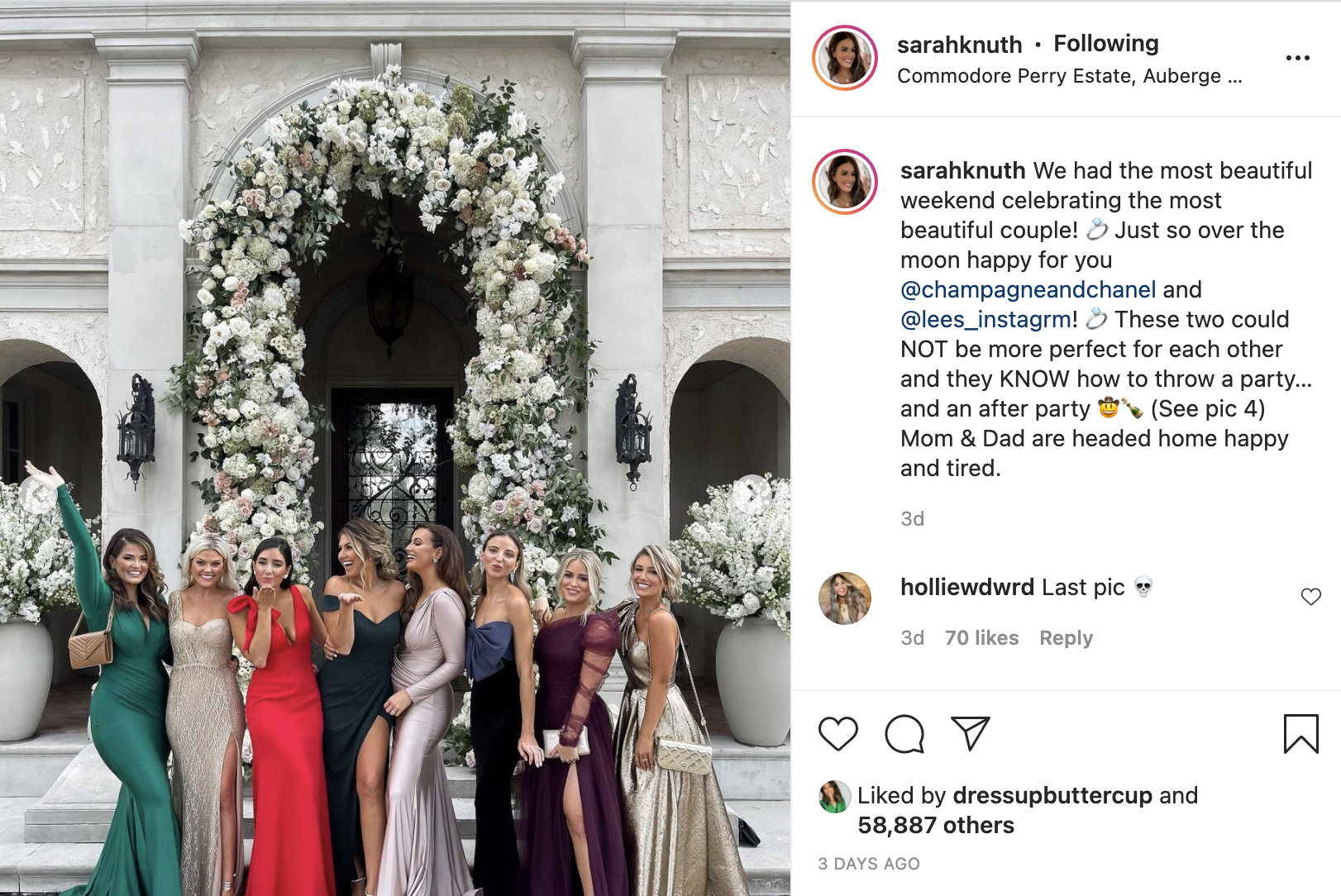This is Please Like Me, BuzzFeed News’ newsletter about how influencers are battling for your attention. You can sign up here.
Champagne and Chanel knows how to Instagram a wedding
On Saturday night I, like millions of people across the country, opened up Instagram for one reason and one reason only: to finally catch a glimpse of Emily Herren’s wedding.
Emily, better known as Champagne and Chanel to her more than 1 million followers on Instagram, married Lee Travis in a glitzy and floral-filled affair in Austin. For months, she had been sharing her plans with her followers, who were eager to see her vision come to life. All over the internet, people admitted they were dying to see what she came up with, and Emily delivered. The wedding was extravagant yet tasteful, and filled with piece after piece of Pinterest-worthy decor, lighting, florals, and table settings.
Being an influencer is, by all accounts, a strange job. For Emily, her everyday life, choices, and style are not just things that she shares, but they are also her work. She makes her money by curating her own magazine of content, with ads, suggestions, and fashion and beauty tips, all based on her own life and preferences. Successful influencers are able to make their lives aspirational, serving as both a friend people can relate to and an icon their followers want to emulate.
So Emily’s wedding served two purposes: one personal and one for her business. It’s a weird paradigm that your wedding is also a way to make a living, but that is the reality influencers have agreed to buy into.
Emily is a master of the genre. Observing her wedding this weekend was like seeing a movie, reading a magazine, and stalking a friend’s photos wrapped into one. She also invited a bevy of influencer friends, who all shared their own content from the event, including creating some great group pic content. Flipping from influencer to influencer was like watching a giant crossover episode of a bunch of your favorite TV shows.

Emily’s wedding was great for her brand. Reddit threads discussing the wedding got thousands of comments. People debated how much she paid for it on Twitter and compared all the dresses of their favorite fashion bloggers on Instagram. After I posted about it on my Instagram, I got a ton of DMs from people who said they couldn’t stay off the platform because they were so obsessed with watching. Her first wedding photo got more than 220,000 likes, nearly quadrupling many of her recent photos. Her influencer friends certainly benefited from the increase in engagement as well.
Does anyone else follow @ champagneandchanel on Instagram because I honestly need to know how much her wedding cost holy shit 🤣
I can understand why people think that the fact that Emily’s wedding was also a professional opportunity is awkward. It’s weird that something so personal can benefit a person financially, and that someone’s business is built on events from their own life. It can lead some people to question everything. Is Emily really friends with all these other influencers, or did she just invite them to create more of an apparatus around her wedding for engagement? How much of her wedding did she get for free? Was all of it free? And does the fact that this wedding is both a personal and professional opportunity mean it’s not genuine?
I get it; it’s a weird situation. However, I think how Emily handled her wedding was refreshing. There’s been a recent trend among influencers to drag out every single life event for engagement in a way that is the antithesis of what it means to be genuine. Instead of sharing the updates in real time, they will slowly tease them for days or even weeks on end, trying to get people to check and refresh their page often to see if they’ve dropped their news yet. For example, a couple who teases their baby’s sex after they are born or spends days dropping hints about their baby’s name.
The biggest example of this in regard to weddings is Peloton instructor and influencer Ally Love, whose wedding I wrote was a “master class in content creation.” I said this because Ally’s rollout was stunning in its precision and uniformity. She saved all of her content until the week after the event and posted about her five-day celebration on a seemingly particular schedule. She also managed to get all of her famous Peloton friends to follow suit on their own accounts, making it seem like each moment was happening in real time and boosting engagement across the board.
It was masterful and impressive. However, in the days and weeks after, Ally faced some criticism. People complained that her rollout was too regimented, and that it felt completely fake. In all of her exacting precision, Ally had lost something in the eyes of her fans: the relatability that made so many of them want to follow her in the first place.
In contrast, Emily’s wedding felt like a breath of fresh air. Emily didn’t seem to put any restrictions on what her guests could and couldn’t post, and many of her influencer, and even non-influencer, friends shared glimpses of the big day that felt natural. Emily also didn’t seem to have a tightly choreographed timetable for the release of the photos, although I am sure she had a content strategy in place.
It all felt incredibly organic. She (or someone she hired to run her account, I assume) posted throughout the day, capturing all the details without making it seem like Emily wasn’t enjoying her own wedding or was ’gramming through it (she shared lots of static photos rather than selfie videos, which could garner criticism she wasn’t living in the moment).
I think this is the way the industry is heading. Amid all the criticism that influencers are out of touch, pampered, and get the world handed to them for free, it behooves them to act more real.
They should cut the gimmicks and give the fans what they want: a look into their lives in real time. Especially if it’s an extremely luxurious, fabulous wedding.
I made the Emily Mariko salmon rice, and it was amazing
This week, I wrote about how I believe viral lifestyle creator Emily Mariko is changing the game, in a good way, for aspirational recipe content. But I also wanted to mention that I made the salmon rice. And everyone, it’s as good as it looks. If you are unfamiliar with Emily or her recipe, watch this video and then come back.
OK, are we good? Excellent.
Viral recipes can sometimes look great on the internet, but be hard to execute in real life. One thing I appreciated about the recipe, the video of which has been viewed more than 24 million times on TikTok, is that it wasn’t too hard to make. Most of the ingredients (soy sauce, Sriracha) I already had on hand, and it was easy to pick up salmon, rice, and avocado. I skipped the kimchi as I am not a fan.
The only challenge was finding Japanese Kewpie mayo, as it was sold out at Target (where I had seen you could buy it online). However, I kind of wonder if that is because of the popularity of the recipe, as seaweed snacks, the final component, were also sold out when I went to Trader Joe’s.
The power of Emily Mariko
Luckily, I snagged a bottle of Kewpie from a market on Instacart. Thus, my salmon rice journey began. I cooked extra salmon the night before (à la Emily) to get the true intention of the recipe: It is supposed to be a leftover hack (who has leftover salmon ever, but I digress).
The whole process of making the bowl took less than five minutes. I made some for myself and my husband, and we both were big fans. It tastes like the inside of a sushi roll, which is all I could ever want in food. It was so easy, and it barely felt like cooking. I get why it’s so popular.
I have to work on my ASMR, and I’m still not sure what the ice cube does, but I am giving this a 10/10.
